How Much Does It Cost to Paint Siding?
Painting your home’s siding is a great way to freshen up the look of your home, create a more modern appearance, or cover up exterior stains and blemishes. It can be significantly less than replacing siding but provide the same appearance.
The cost to paint your home’s siding depends largely on your siding material and the type of paint you use. It can run anywhere between $2,500 and $7,000, with most homeowners paying $3,000 on average for a 1,500 sq. ft. home with aluminum or vinyl siding and using moderately priced paint finishes. It can cost as low as $1,000 for a 500 sq. ft. home with wood or aluminum siding and using a matte-style finish. It can also run as high as $10,000 for 3,000 to 3,500 sq. ft. homes with brick or stucco siding, using any type of finish.
Cost to Paint Siding
| Cost to Paint Siding on House | |
|---|---|
| National average cost | $3,000 |
| Average range | $2,500-$7,000 |
| Low-end | $1,000 |
| High-end | $10,000 |
Siding Painting Cost by Project Range
Siding Paint Cost by Type
Another main component that affects the cost of painting your home’s exterior is the type of paint you choose for the finish paint, which will run, on average, $29 per gallon. The type of paint you use will depend on the material being painted and the final look you want to achieve.
You can expect to pay around $27 per gallon for acrylic exterior siding paint, a water-based paint that adds acrylic to act as a binding agent. It can be used in wood, aluminum, or vinyl 1 siding and is popular because of its durability and longevity.
Latex paint will run around $29 per gallon and is a water-based paint, contrary to what the name may imply. It is a popular option as it is one of the easiest types of paint to keep clean and remove when needed. The main drawback is it does not have the longevity of other options.
Oil-based exterior siding paint creates one of the most durable finishes, making it one of the top choices for painting siding. On average, you can expect to pay $31 for a gallon of oil-based exterior paint. Even though this type of paint can stand up to the elements and last for years and years, it does have a few drawbacks. It takes longer to cure, has a higher tendency to crack, and emits a strong odor during the application process.

| Type Of Paint | Best Used on | Average Cost Per Gallon (Only Materials) |
|---|---|---|
| Acrylic | Wood Aluminum Vinyl | $27 |
| Latex | Brick Concrete Soft Wood Vinyl Galvanized Metal Stone | $29 |
| Oil | Aluminum Wood | $31 |
Siding Primer Cost by Type
On average, you can expect to spend $30 per gallon for primer 2, depending on the type of primer you choose for the project. When painting, your exterior siding primer can give you better coverage, allow the paint job to last longer, and enhance the overall appearance of the paint job. The primer you choose will largely depend on your siding’s surface type, along with the type of paint you have chosen for your project.
Latex primer is one of the most economical primers, costing $20 per gallon on average. It is more flexible and less brittle than other primer types, making it less likely to crack or peel. Latex primer can be used on various exterior surfaces, such as brick, galvanized metals, soft wood, concrete, and some plastics. It is not as good at covering stains but is popular due to its ease-of-use and low odor.
On average, oil-based primers run about $25 per gallon. Using oil-based primer for aluminum siding provides you with a protective barrier between the oxidized aluminum and finish paint. When the painter is preparing the surface, they will use oil-based primer on any bare aluminum that will be covered. Oil-based primer is not only ideal for aluminum siding but wood as well. It can help to seal the surface of the porous wood to allow the finish coat of paint to fully cover the surface.
On average adhesive primer will cost $40 per gallon. It is an excellent option for surfaces that are hard to paint as it provides for better bonding. It can also be used in areas of high humidity and still result in a smooth base coat. It works on many types of exterior siding surfaces, including wood, metal, and plastics. It also works with various top coat options, including latex and oil-based paints. It is extremely durable and dries quickly.
Shellac primer can be expensive, costing an average of $55 per gallon. It is one of the types of primers that has been around the longest and is used to seal wood and other types of surfaces. It is known as one of the best stain-blocking primers, making it ideal for protection against the elements. It can be used on exterior surfaces made of wood, plastic, and metal and is known to be quick-drying. The primary drawback to this type of primer is the fact that it gives off stronger odors.

| Type Of Primer | Best Used on | Average Cost Per Gallon (Only Materials) |
|---|---|---|
| Latex | Brick Concrete Soft Wood Vinyl Galvanized Metal Stone | $20 |
| Oil | Aluminum Wood | $25 |
| Adhesive | Wood Metal Vinyl Plastics | $40 |
| Shellac | Wood Plastic Metal | $55 |
Average Cost to Paint Siding by Finish
Choosing the right paint finish for the exterior of your home depends on the desired look you are trying to achieve and the properties you are looking for, such as the ability to keep it clean or the amount of light it reflects. Depending on the finish you choose, you can expect to pay between $23 and $32 per gallon. When you hear the term finish, it refers to the amount of light that the paint will reflect from the surface. Paints with a sheen will reflect more than matte finished, which absorbs the light.
Flat paints are one of the most commonly used types of finishes for exterior siding. It is non-reflective, smooth, and good at hiding blemishes. They run $23 a gallon on average, making it one of the most economical options. It is easier to touch up and requires fewer coats.
Eggshell finishes run around $30 a gallon and have a little more sheen than flat paint but absorb the light more than gloss finishes. It is easier to wash than flat paint and is more resistant to stains.
One of the most popular sheens is satin, which gives a pearl-like finish to surfaces. It is mildew and fade resistant and easier to clean than flat or eggshell finishes. It works great on siding and for painting other exterior trim. You can pick up a gallon of satin exterior paint for about $26. Semi-gloss costs around $27 per gallon and produces a more sleek, shiny appearance. It is moisture-resistant and handles high levels of humidity. Semi-gloss is extremely easy to clean but shows more blemishes than more matte-like options. High-gloss exterior paint produces the most reflection and has the same moisture-resistant properties as semi-gloss. The main drawback is it can take more than one coat to achieve total coverage. A gallon of high-gloss paint runs about $32 per gallon.

| Type Of Finish | Average Cost Per Gallon (Only Materials) |
|---|---|
| Flat | $23 |
| Satin | $26 |
| Semi-gloss | $27 |
| Eggshell | $30 |
| High-gloss | $32 |
Cost to Paint Siding
It is best to have your home’s exterior painted by a professional painter. They have the experience to make sure that the siding is properly prepared and the desired coverage is achieved so that you end up with a professional-looking appearance. The cost to paint exterior siding includes the cost of material and an hourly painting rate that runs between $50 and $100 per hour, depending on the average labor rates in the area. Most professionals will paint in teams, usually consisting of two to three painters. You can expect it to take three to four days to paint a 1,500 to 2,000 square foot home, including prep time and time for coats to dry. This runs on average between $2,000 and $3,500 for this type of job.
Cost to Paint Siding per Square Foot
The cost per square foot to paint exterior siding ranges between $0.50 per square foot and $2.50 per square foot, with an average of $2.00 per square foot. Lower square footage costs are more common for wood and aluminum siding, where the higher cost is more common for complicated siding paint jobs, such as brick and stucco. The total cost to paint the siding on your home primarily depends on the amount of square footage that the painters will have to cover. The more square footage, the higher the costs of materials, and the longer the project will take. Below is a list of some of the most common square footage amounts and the cost of siding paint projects with the cost of labor included.

| Home Square Footage | Siding Size | Average Cost (Including Labor) |
|---|---|---|
| 500 sq. ft. | 1000 sq. ft. | $500 - $2,500 |
| 1,000 sq. ft. | 1500 sq. ft. | $750 - $3,750 |
| 1,200 sq. ft. | 2000 sq. ft. | $1,000 - $5,000 |
| 1,500 sq. ft. | 2500 sq. ft. | $1,000 - $6,250 |
| 2,000 sq. ft. | 3000 sq. ft. | $1,500 - $7,500 |
| 3,000 sq. ft. | 4000 sq. ft. | $2,000 - $10,000 |
Average Cost to Paint Siding by Number of Stories
Another factor that affects the cost of painting siding is how many stories your home is. Second and third stories require additional labor and equipment, increasing the overall cost of the project. Your cost to paint siding on a second or third story may also be affected by the design of your roof. If more edging is required, the cost may increase. Below is an average price calculation for what you may expect to pay with labor costs for a siding paint job based on the number of stories your home has.

| Number Of Stories | Average Project Cost (Including Labor) |
|---|---|
| One Story | $2,500 |
| Two Story | $4,500 |
| Three Story | $6,500 |
Cost to Paint Siding by Material
Siding is the bulk of your home’s exterior and the bulk of any exterior painting project. The average cost to paint just the siding is around $2,000 to $4,000 for 1,500 sq. ft., depending on the type of siding and the number of coats of paint it requires.

| Type Of Siding | Average Cost to Paint 1,500 sq.ft. | Cost Per Square Foot |
|---|---|---|
| Metal/Aluminum | $1,250 - $3,700 | $0.83 - $2.50 |
| Engineered Wood | $1,500 - $3,000 | $1 - $2 |
| Wood | $1,500 - $4,500 | $1 - $3 |
| Concrete | $1,500 - $5,250 | $1 - $3.50 |
| Fiber Cement | $1,875 - $4.875 | $1.25 - $3.25 |
| Vinyl | $2,025 - $4,000 | $1.35 - $2.75 |
| Steel | $2,250 - $3,700 | $1.50 - $2.50 |
| Stucco | $2,250 - $6,000 | $1.50 - $4 |
| T-111 | $2,250 - $6,000 | $1.50 - $4 |
| Brick | $3,600 - $6,300 | $2.40 - $4.20 |
| Stone | $3,600 - $7,500 | $2.40 - $5 |
| Stone Veneer | $3,750 - $6,750 | $2.50 - $4.50 |
| Brick Veneer | $3,750 - $6,750 | $2.50 - $4.50 |
Cost to Paint Aluminum Siding
Aluminum is easy to paint and may use less paint than wood, so the costs are generally around $1,250 to $3,700 for a 1,500 sq. ft. home or $0.83 to $2.50 per sq. ft. Aluminum siding tends to fade and become chalky over time. When this happens, it needs to be repainted.
Aluminum siding usually requires specific types of paint to ensure proper coverage, increasing the cost by 10% to 20% over less expensive options. When painting aluminum, it is often recommended to put on two coats of paint to create a smooth look and provide maximum coverage.
Paint Engineered Wood Siding
The average cost to paint engineered wood siding is closer to $1,500 to $3,000, or $1.00 to $2.00 per sq. ft. Engineered wood siding is frequently already primed. It is also less likely to require as much paint as bare wood siding, so costs are generally lower as it takes less of both time and material to cover.
Cost to Paint Wood Siding
Bare wood siding requires a primer 2. Wood in poor condition may require at least two coats of paint. You can expect to pay between $1.00 and $3.00 per sq. ft. for painting. This makes the average cost to paint wood siding around $1,500 to $4,500 for 1,500 sq. ft. Before painting, it is critical to properly prepare the area by removing loose paint and creating a smooth surface. This will allow for better adhesion and a more aesthetically pleasing finish. Even though preparation may take some time, painting wood siding can be a relatively easy process making it a more economical way to update the look of your home than replacing siding.
Cost to Paint Exterior Concrete Walls
Painting concrete runs between $1.00 and $3.50 per sq. ft. The concrete requires a primer to prevent the paint from peeling and usually requires more paint as well, for a higher cost of around $1,500-$5,250 for 1,500 sq. ft. While rare, there are some homes and some areas of homes with concrete walls. Some homeowners choose to leave these bare, while others choose to paint.
Paint Fiber Cement Siding
Fiber cement 3 siding is usually already painted for installation but can also be purchased pre-primed for a custom paint job. For 1,500 sq. ft., you can expect to pay $1,875 to $4,875 on average, or about $1.25 to $3.25 per sq. ft. It requires repainting after about ten years or so but is usually faster and easier than wood because it’s a non-porous surface that takes paint easily and uses less paint in general.
Cost to Paint Vinyl Siding
Vinyl 1 siding is often touted as being maintenance-free, but if you want to change the color, it is possible to paint it. Vinyl siding must be cleaned then coated in an adhesive primer before being coated with at least two coats of acrylic latex paint. Therefore, it has a higher cost to paint vinyl siding than other types of siding, with starting costs closer to $2,025 to $4,000 for 1,500 sq. ft. The higher cost is directly related to the need for specialized paint, which can cost between 10% and 20% more. You can expect to pay between $1.35 and $2.75 per sq. ft. to get the job done.
Paint Steel Siding
Steel siding is handled almost identically to aluminum siding in most instances. It costs between $1.50 and $2.50 per sq. ft. to paint. Some types of steel siding are designed to never need painting again. These types may require special primers before painting. It’s best to check with the manufacturer. Other types can be painted like aluminum for around the same cost of $2,250 to $3,700 for 1,500 sq. ft.
Paint T-111 Siding
Painting a 1,500 sq. ft. home with T-111 siding will cost between $2,250 and $6,000 or $1.50 to $4.00 per sq. ft. T-111 is plywood 4 siding or painted osb siding, designed to give a more natural appearance to exteriors. Each piece is routed to give the appearance of wooden planks. Acrylic exterior paint works best when painting new T-111 siding. It will need to be repainted or touched up about every ten years to combat the effects of weathering.
Before painting, all of the siding will need to be cleaned, have previous paint removed, and have any damaged or loose boards replaced or repaired. This type of siding requires a primer and typically needs two coats to achieve full coverage. It also requires special brushes to get into the routed areas. After the second coat has been given time to completely dry, it may need some minor retouching as it is a more absorbent siding type.
Cost to Paint Brick House
Homes done entirely in brick can be painted for between $3,600 and $6,300, or between $2.40 and $4.20 per sq. ft. Brick takes less paint but requires more labor to get a solid coat. Brick siding is porous. The lack of a smooth surface requires the use of smaller painting equipment, which takes longer to complete. Even though it can take longer to paint, it requires less time to prep. Often, only power washing is required before the primer is applied.
It is important to note that painting on brick needs to be redone every four to six years. You want to be sure that all of the brickwork and mortar 5 is repaired before beginning the painting process.
Paint Stone Siding
Stone siding on homes can be painted for $2.40 to $5.00 per sq. ft., around $3,600 to $7,500 for a 1,500 sq. ft. home and give an updated appearance to stone that has become weathered. While most stone exteriors boast a smooth finish, it is not flat siding, so it can require additional painting equipment and more labor to complete the job. Prep time is minimal, the same as with brick exterior, and it can sometimes be covered in one coat when using high-quality paint. Homeowners should be aware that once stone is painted, it needs to be touched up or repainted every few years to maintain a fresh appearance.
Painting Exterior Stone Veneer
Painting stone veneer costs between $2.50 and $4.50 per sq. ft., which will be between $3,750 and $7,500 for a 1,500 sq. ft. home. If you have engineered stone on your home, it is possible to paint it a solid color to help it blend in with the rest of the exterior. Most stone siding is not actually stone but is a type of fiber cement. Therefore, it holds paint similarly to fiber cement, but because it’s not primed the way that planks are, it will need to be primed and then painted.
Paint Brick Veneer Siding
Homes will brick veneer 6 siding will cost between $3,750 and $6,750 or $2.50 to $4.50 per sq. ft. to paint for an average 1,500 sq. ft. home. Brick veneer requires minor preparation before painting, including peeling away loose paint and removing any mineral deposits. After washing, the veneer should be allowed to dry overnight to avoid trapping moisture during the painting process.
Brick veneer should be primed using a 100% acrylic exterior primer and 100% acrylic exterior paint. It will require both roll and brush painting to properly cover the entire surface. In most cases, a second coat is required to achieve the desired look.
Cost to Paint Stucco House
Stucco also has specialty processes, and your project will often include needing to make some minor repairs to the surface before it can be painted. This makes the cost of painting stucco slightly higher, around $4,500 to $9,000, or roughly $3.00 to $6.00 per sq. ft. Also, damaged areas should be patched, and any peeling areas should be removed and re-stuccoed. Painting the stucco on the exterior of your home is a great way to update the look and hide stains and blemishes. If your home has been freshly stuccoed, let it cure for at least 60 days before attempting to paint. Your painter should have special tools, depending on the texture of the stucco, to ensure proper coverage.
Cost to Repaint Siding
Over time paint may begin to chip or peel. In these situations, painting old siding will be necessary to maintain a clean look on your exterior. Depending on the type of weather it is up against and the painted material, it may begin to look damaged in as little as four years. In this case, you may want to consider having your siding repainted and touched up. On average, repainting siding costs less than painting, running between $2,000 and $3,000. The cost will vary and depend on whether you choose a completely new paint color and whether or not repairs will be made. If painting with a completely new color, you may need to remove the old paint, reprime, and repair, which can be the same cost as the initial painting. But if you are repainting with the same color, or a darker one, you may paint over the previous paint and primer as long as it is smooth and properly cleaned. This will significantly reduce the overall cost.
Preparing Siding for Painting
The key to effectively painting your siding is preparing it properly. Your painting professional will start the process by performing a full examination of the siding. They will check for the presence of asbestos, dirt, mold, and mildew. If any of these items are found, it can require additional cleaning and preparation, which will increase the cost of the job and the length of time for it to be completed. Removing asbestos siding runs between $10,500 and $13,500. An inspection for mold adds about $400 to $800.
The siding will be inspected for damage. If repairs are needed, they will be addressed before the cleaning process begins. If, upon inspection, water damage, cracked stucco 7, or rusty nails are found, your home may need to be checked for structural damage before the process moves forward.
Once everything has been inspected and all repairs have been made, it is time for your professional to begin the cleaning process. Depending on the extent of cleaning needed, you may pay between $500 and $700 to get your siding ready to paint. Any loose paint needs to be removed, and dark stains should be addressed so they do not bleed through. If there are rough surfaces, they should be sanded down. While your professional will have addressed repairs before the cleaning process, they may need to complete additional caulking 8 and filling of cracks after the process if new ones have formed during preparation. Once the cleaning has been completed, the siding needs to dry for at least 24 hours before the primer can be added, and the painting process can begin.

Siding vs Painting Cost
Painting siding is a significantly cheaper option than replacing siding. Painting siding can run between $1,000 and $7,000 depending on the size of the house and material being used, and averages around $3,000 for a 1,500 sq. ft. home. Installing new siding will cost, on average, $13,500 for a 1,500 sq. ft. home and can run between $7,500 and $22,500. Repainting will likely be the best option if your siding is weathered, faded, or needs a new look. Minimal damage can be repaired before painting, even if it includes replacing a few pieces. But if your siding is significantly damaged or has damage over more than 50% of it, it may be more cost-effective to replace your siding.
Additional Considerations and Costs
- Homes with unique architectural features, such as mismatched windows, steep roof lines, or lots of edging, may require more prep work and labor costs.
- Homes built before 1978 may still have lead paint on the siding. If this is the case, the painter will need to scrape and remove the paint. This job can be toxic, so it should only be done by a professional. This can add an extra $12,000 to $22,500 for a home with 1,500 sq. ft. of siding.
- Using multiple colors, even for small accents, adds up to an extra $1,000 per 1,500 sq. ft., depending on the number of colors and the area they cover.
- Painting exterior siding does not normally require a permit like installing siding, since it is not considered altering the structure of your home. Still, it is always advisable to check with your local municipality just in case.
- While it is possible to paint the exterior of your home yourself, it can be a daunting task, especially if you don’t have the professional tools needed for preparation and painting. Acquiring these tools and the amount of labor it will take will likely not be worth the money saved. Additionally, a professional will be able to properly inspect your siding to ensure that it is in the best condition before painting.
- Repainting your siding can definitely increase the value of your home and is advisable if you have older siding and plan to sell your home. It significantly enhances curb appeal, gives the appearance of a well-maintained home, and makes older homes look newer. On average, painting your siding can add about $3,000 to $6,000 to the value of your home.
- If you want to know what color to paint your siding depending on the color of your roof, you can use this interactive tool to figure out the best combination.
FAQs
- Is it cheaper to paint aluminum siding or replace it?
Painting aluminum siding can run between $1,250 and $3,700 for a 1,500 sq. ft. home. Installing aluminum siding can run between $7,500 and $22,500, making it the more expensive option though it may be necessary if the siding is damaged. It is important to note that once you paint your aluminum siding, you will need to redo it about every four to six years.
- Is painting vinyl siding a good idea?
If your vinyl siding is in good condition but has mild weathering or fading, then painting it can give it a fresh look and is a better option than replacing it due to the lower cost.
- How long will my vinyl siding last if I paint it?
As long as you have properly cleaned and prepared your vinyl siding before painting it, the paint should last ten years, only requiring minor retouching.
- Is painting siding a good idea?
Painting your siding is a less costly way to freshen up the look of your exterior or change the aesthetic appearance of your home. Proper preparation is key to ensuring the job is done properly.
- How much does it cost to paint vinyl siding?
It will cost an average of $2,025 to $4,000 to paint the vinyl siding on a 1,500 sq. ft. home.
- What kind of paint do you use on siding?
To paint siding, you need to choose a high-quality exterior paint designed to withstand the elements. You also need to choose a paint type designed to work with the material used for your siding. It is also advisable to use colors that won’t absorb too much heat so you can keep your home more energy-efficient.
Remodeling Terms Cheat Sheet
Definitions in laymen's terms, cost considerations, pictures and things you need to know.See full cheat sheet.
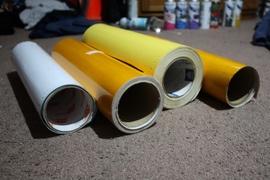 1 Vinyl: A synthetic plastic made from ethylene and chlorine. Vinyl has many applications in the construction industry and it is widely used in sidings, window frames, roofing and gutters, among others
1 Vinyl: A synthetic plastic made from ethylene and chlorine. Vinyl has many applications in the construction industry and it is widely used in sidings, window frames, roofing and gutters, among others
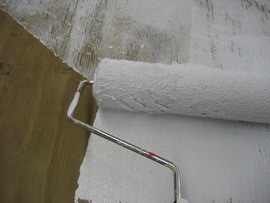 2 Primer: Preparatory coat applied to materials (drywall, wood, metal, etc.) before painting to ensure paint adhesion, extend paint durability, and help seal and protect the surface to be painted
2 Primer: Preparatory coat applied to materials (drywall, wood, metal, etc.) before painting to ensure paint adhesion, extend paint durability, and help seal and protect the surface to be painted
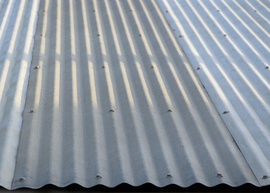 3 Fiber cement: A building material made with cellulose fiber, concrete, and recycled materials such as glass
3 Fiber cement: A building material made with cellulose fiber, concrete, and recycled materials such as glass
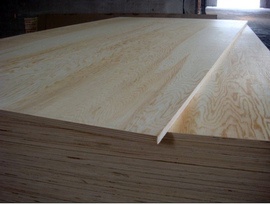 4 Plywood: An engineered construction material manufactured from thin slices of wood glued together in alternating grain patterns for strength
4 Plywood: An engineered construction material manufactured from thin slices of wood glued together in alternating grain patterns for strength
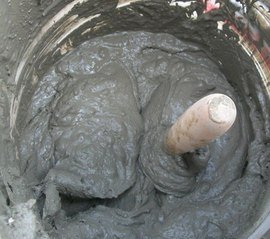 5 Mortar: A mixture of Portland cement or lime or a combination of both, sand, and water used to bind bricks, stones, and concrete masonry units together
5 Mortar: A mixture of Portland cement or lime or a combination of both, sand, and water used to bind bricks, stones, and concrete masonry units together
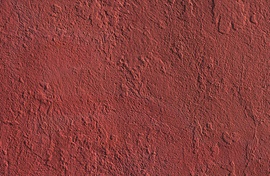 7 Stucco: A type of durable plaster finish made of aggregates, a binder, and water (traditionally Portland cement, sand, and water) used on masonry, walls, ceilings, and decorative moldings
7 Stucco: A type of durable plaster finish made of aggregates, a binder, and water (traditionally Portland cement, sand, and water) used on masonry, walls, ceilings, and decorative moldings
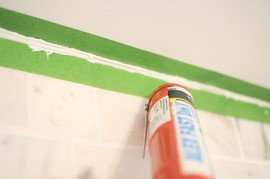 8 Caulking: A chemical sealant used to fill in and seal gaps where two materials join, for example, the tub and tile, to create a watertight and airtight seal. The term "caulking" is also used to refer to the process of applying this type of sealant
8 Caulking: A chemical sealant used to fill in and seal gaps where two materials join, for example, the tub and tile, to create a watertight and airtight seal. The term "caulking" is also used to refer to the process of applying this type of sealant
How much does it cost to paint siding in my city?
Cost to paint siding varies greatly by region (and even by zip code). To get free estimates from local contractors, please indicate yours.







